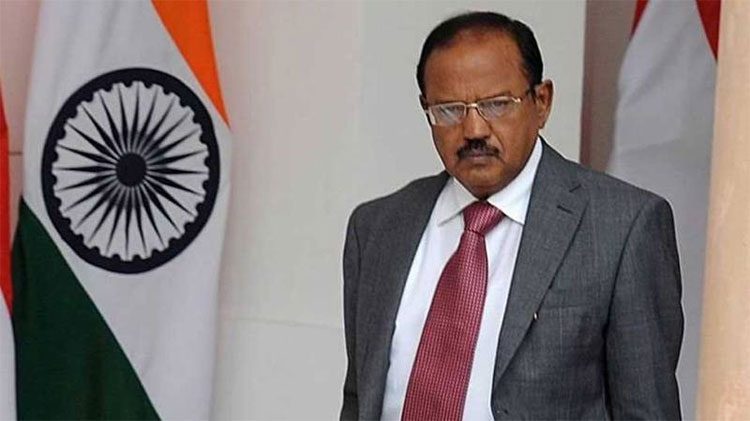When I watched the recording of Ajit Doval’s speech at IIT Madras, I wasn’t watching a statesman. I was watching a craftsman at work. The air in that lecture hall on July 11th may have been cool and sterile, but the performance was anything but extraordinary.
I saw a man for whom truth has long been a malleable commodity look out at a sea of young, trusting faces—not as a future to be protected, but as a blank slate onto which he could impose the state’s official narrative. Ajit Doval wasn’t building a fortress of words to shelter them; in my view, he was building a prison, walling them off from the inconvenient reality flickering on screens right outside that hall.
With the chilling arrogance of a man who believes he owns the truth, he decreed a version of “Operation Sindoor” scrubbed clean of failure, demanding their belief as a matter of patriotic duty. This carefully crafted lie was his shield, held up against the grainy, chaotic reality that I and so many others had been tracking for weeks. He was offering these students, whose lives are mapped out in the certainties of code and equations, a reprieve from the messy truth of reprisal—of fire and impact.
He may believe he was performing an act of national service, but what I saw was a man trying to make his entire country untouchable by rewriting reality.
Then came the centerpiece of his fiction: “There isn’t a single photograph that shows any Indian damage… Not even a broken glass pane,” he declared.
Let me be blunt: that is a brazen fabrication. And it’s a lie designed to hide a truth I believe is humiliating for his establishment: that India’s aggression was met with a swift, decisive, and punishing response from Pakistan. When Mr. Doval challenges the world to “show me one photo,” he insultingly ignores the mountain of evidence that invalidates his every word.
The question isn’t whether the evidence exists. I’ve seen it. The real question is why India has chosen institutional blindness over accountability.
A Tale of Two Realities: The Myth I’m Told vs. The Facts I See
India’s narrative, which I’ve seen amplified with fervent jingoism by its domestic media, is a tale of a flawless 23-minute strike. It’s a brilliant piece of fiction. But it conveniently ends right before the chapter I witnessed: the meticulously planned retaliation by Pakistan.
Let us be clear about what the evidence shows. The smoke that rose near the Udhampur Air Base was not a weather phenomenon. The emergency alerts that blared across northern India were not a drill. The satellite images that I and other international analysts have scrutinized, showing damage to military infrastructure, are not illusions. While India’s media was broadcasting victory laps, Pakistan’s response was, from my analysis, effectively targeting the very assets that make up the backbone of their offensive capability.
This wasn’t a rash reaction. It was a calibrated demonstration of capability. The shutdown of airbases and the scramble of emergency services were not signs of a nation on alert; they were the signs of a nation that had been caught off-guard and hit where it hurts.
The Hypocrisy of a Managed War
What I find most staggering is the hypocrisy. In that same speech, Doval accused The New York Times and the foreign press of bias. So on one hand, I am expected to accept India’s version of events without question. On the other, the exhaustive, multi-source evidence of Pakistan’s counter-strike is to be dismissed by his government as mere propaganda.
This is a classic information warfare strategy: praise the media that prints your script and condemn any that dares to question it. As Doval decries “media management” from abroad, I have to ask: where are the Indian journalists? Where are their investigative reports from the sites of these alleged strikes? Their collective silence is deafening and, to me, speaks volumes about the level of state control over information.
This double standard is an insult—not just to Pakistan, but to the intelligence of the global community.
Denial Is a Confession
Ultimately, Mr. Doval’s attempt to shape public memory by denying contrary evidence is a strategy I am convinced will fail. The hundreds of images circulating, the expert analyses—they form a compelling mosaic of truth that no amount of official denial can erase.
This brings me to the question people should be asking themselves as they scroll through their phones late at night: “If everything is fine, then why do these pictures exist?” Some will choose to believe the crisp, official statements. They will trust the lie. But for many others, a different story lingers. It’s a story felt in the memory of smoke-stained horizons, the chilling sound of jets tearing through the sky, and the strange, heavy silence from news channels where answers should have been.
So when Mr. Doval challenges us to “show one photo,” I say the evidence is already overwhelming. His denial is not a projection of strength. It is the clearest reflection of an establishment struggling to face the fact that its military adventurism was met with a resolve it fundamentally underestimated.
Accountability, not denial, is the true measure of a nation’s power.


Leave a Comment